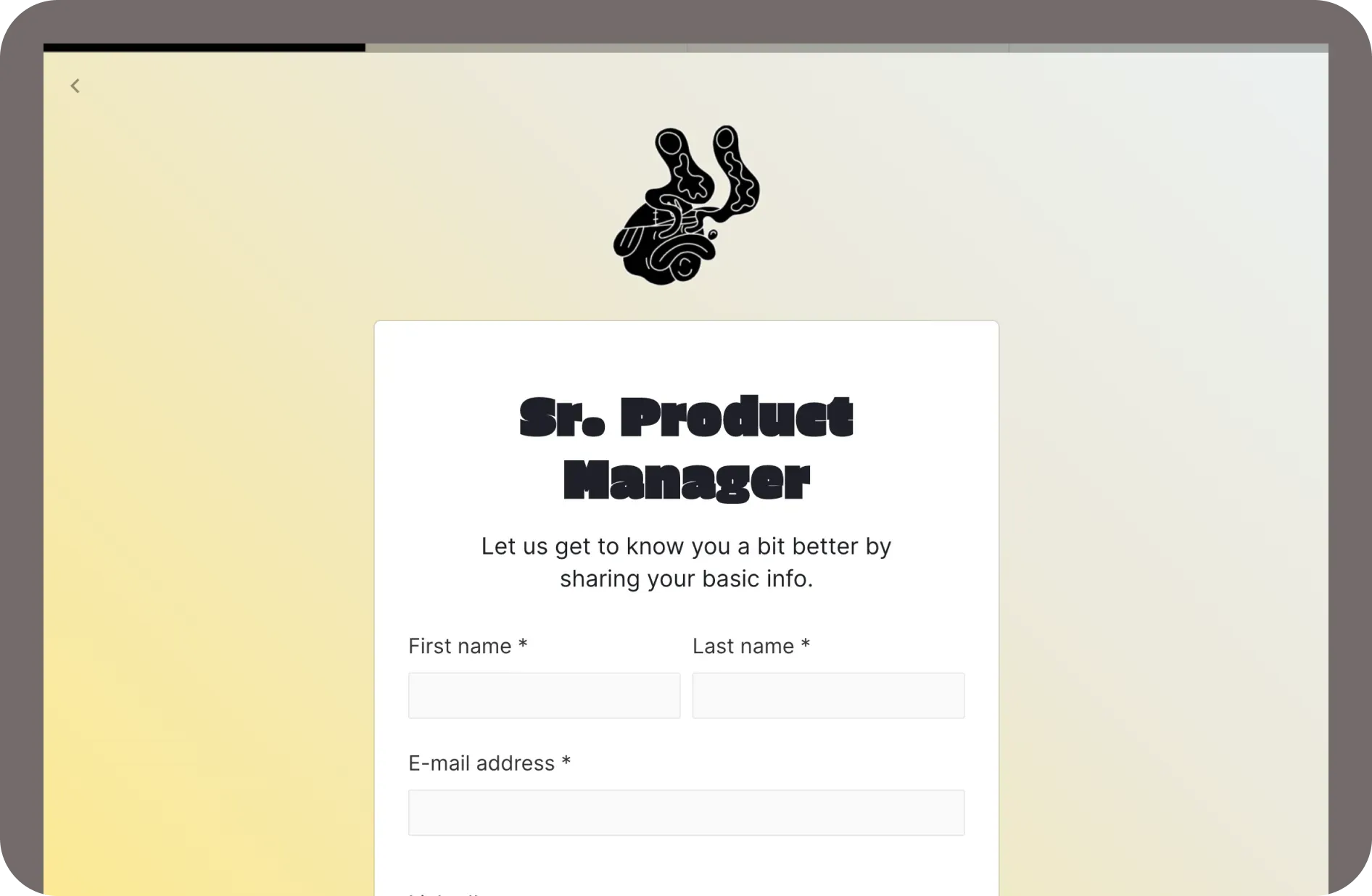
There's no one-size-fits-all approach when it comes to job applications.
What should you ask from applicants? Should you request a CV, a portfolio, a LinkedIn profile or perhaps a combination of these? Or should you take a different approach altogether?
The answer is the classic "It depends!" The right choice hinges on the industry, the role, current job market trends and your hiring goals.
In this article, we'll look at the pros and cons of asking for a CV in your job application process and examine when other formats might be a better fit for your next open role. Let's go!
What's the difference between a CV and an application form?
- A CV (curriculum vitae) or résumé 🇫🇷 is a structured document that presents a candidate's career history, qualifications, skills and achievements. Hiring managers and recruiters use it to evaluate candidates based on their experience and qualifications.
- A job application form is a customizable form created by your hiring team to gather specific information about candidates, tailored to the role and your company's needs. You can expect to see fields for work experience, salary expectations, earliest start date, visa requirements and even creative prompts that go beyond the scope of a traditional CV.
You can still ask applicants to attach their CVs to your form, especially if you're using an online job application form builder. The question remains: should you keep or ditch the CV?
📣 See our job application questions for more inspiration
Pros and cons of asking for a CV in a job post
Let's be clear — CVs still have their place, especially in industries where specific work experience and qualifications are crucial (think operations, administrative roles, hospitality or technical fields like IT).
However, candidate expectations are constantly evolving, and there are pros and cons to requesting a CV in today's job market. It's worth considering your options when publishing a job posting.
To CV or not to CV? Let's dive in:
Pros of a CV 👍
- You get more structured information
A CV provides a format for understanding a candidate’s career path, making it easier for hiring managers to assess candidates and get the information they need from their job application. From education to work experience, a CV provides hiring managers with the key information they’re looking for. Easy peasy. - You see a comprehensive candidate overview
CVs typically include everything from work experience to education, skills, certifications, interests and achievements, giving you a full picture of the candidate’s professional background. They can sometimes also give a small insight into who they are outside of work, too. - Everyone’s got one (pretty much)
A bonus of CVs and résumés is that… just about everyone has one! It’s easy for applicants to attach an already-created CV to your job posting and submit their application.
Cons of using a CV to assess applicants 👎
- There are limitations for creative roles
In fields like design, marketing or professional writing, a CV might not showcase the candidate’s full potential. Portfolios, work samples or project-based evaluations can be more useful to help you gauge creative talent. - It’s difficult to reflect an applicant’s personality and soft skills
CVs focus a lot on experience and qualifications, but they don’t always give you insights into a candidate’s communication style, problem-solving abilities or cultural fit. - CVs can be generic
Some candidates (understandably) recycle CVs across multiple job applications, leading to generic submissions that don’t reflect specific enthusiasm or relevance for your role. - You may make inaccurate comparisons
While CVs bring some traditional structure to the hiring process, they can also lead to inaccurate candidate comparisons. From CV formats to the detail of information they provide, each candidate will submit a different CV making it trickier to evaluate your applicants equally, side by side.
Pros and cons of using an application form in a job post
Application forms empower recruiters and hiring managers to customize the information they gather from job applicants, ensuring it perfectly matches the role and company requirements. This flexibility makes them a super valuable tool in the recruitment process. However, like any tool, application forms have their own set of advantages and limitations.
📣 How to create the best job application form out there
Pros of using an application form ➕
- Tailored to your needs
Unlike a generic CV, an application form allows you to ask for exactly what you need. You can include custom fields, such as specific qualifications, skill sets, or even hypothetical questions to gauge problem-solving abilities. This makes it easier to filter candidates who meet your specific criteria. - Standardized responses
By asking all candidates the same questions, you can compare applications more fairly and consistently. This structure ensures that you receive the same type of information from each candidate, which simplifies the evaluation process. - Showcase soft skills
Application forms give candidates a chance to express themselves through open-ended questions or specific prompts. You can ask questions that assess soft skills, such as communication, leadership, and teamwork, which don’t always shine through in a CV. - Pre-screening potential
Some forms can include ‘knockout’ questions, like asking whether candidates are legally eligible to work in your country or if they have a required certification or a driver’s license. This allows for early pre-screening, saving you time later in the hiring process. - Encourages creativity
Application forms often have questions requiring creative problem-solving or unconventional thinking, allowing candidates to showcase how they approach challenges. This can better gauge their potential in the job you’re hiring for.

Cons of using an application form ➖
- Time-consuming for candidates
Depending on how many fields or questions you include, application forms can be lengthy and time-consuming, potentially deterring top talent from completing the process. Candidates may abandon the application if it feels overly complicated, repetitive, or time-consuming. - Risk of generic responses
If your questions are too broad or repetitive, candidates may give generic answers, making it harder for you to differentiate between applicants. To avoid this, ask targeted, thoughtful questions that prompt meaningful responses. - Information overload
If you ask too many unnecessary or irrelevant questions, you could end up with a flood of information that doesn’t actually help in assessing candidates.This can slow down your review process and make it harder to focus on the key details that matter.
If not a CV, then what? Alternatives to CVs in the application process
In certain industries or for specific roles, asking for a CV may not be the best approach. And if you’re looking to switch up your application process and take a more untraditional approach, you have some options.
Here are a few alternatives that can provide a more accurate picture of a candidate’s potential:
1. Portfolios or project samples
For creative roles, portfolios showcase an applicant’s real-world work so, it can be easier to assess a candidate’s skills and creative process. For roles that require very specific skills (e.g., coding, content creation or marketing), asking for work samples or project-based assessments allows candidates to show off their abilities in a real-world context.
Designers, writers, videographers/photographers and marketers are often evaluated more effectively through their portfolios than through a CV. For results-based roles, like marketers, you can also look out for quantifiable results attached to an applicant’s portfolio work.
2. LinkedIn profiles
Some recruiters (and candidates) prefer LinkedIn profiles over traditional CVs. After all, candidates are more likely to keep their LinkedIn profiles up-to-date, more regularly than their CVs — it’s more visible, it’s public and it’s often a lot easier!
LinkedIn provides similar information to CVs of course, but also contains recommendations, and allows a more comprehensive view of the candidate’s network and endorsements. This may sway you to consider using LinkedIn profiles rather than CVs!
3. Application form prompts and questions
If you’re looking for something more customized, an application form with tailored prompts (e.g., "How would you approach X challenge at our company?") can help you learn a lot about an applicant.
Questions like this will help you gauge how a candidate thinks, plans and solves problems—insights that a CV won’t easily provide. Plus, you’ll get to hear from them in their own words, not in formal and sometimes robotic CV-speak.
When you use an applicant tracking system (ATS) like Homerun, you can add custom questions, including multiple-choice, yes/no, file upload and text-based questions.
So… are application forms or CVs better for your recruitment?
At the end of the day, the choice between a CV and an application form depends on the role you're hiring for. Traditional CVs are ideal for positions where experience and qualifications are paramount, while creative or technical roles may benefit more from portfolios or work samples.
Regardless of your approach, remember that your primary goal is to gather information that best helps you evaluate a candidate's suitability for both the role and your company culture.
💡My two cents: Even if you decide to forgo CVs, always include an online job application form in your process. It makes your jobs more accessible, attracts a wider range of applicants, and allows candidates to showcase their true selves. With a well-designed job application form, you can collect the same information you'd get from a CV. As a bonus, you'll save time by avoiding the need to compare vastly different CV formats for the same role.
Put this strategy in place to streamline your hiring process, minimize uncertainty and ultimately find and hire the right person for your team more efficiently.













.png)

